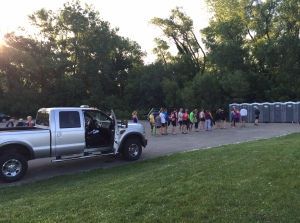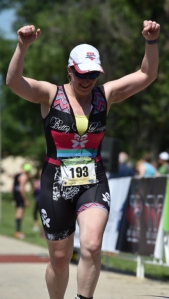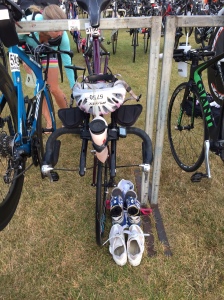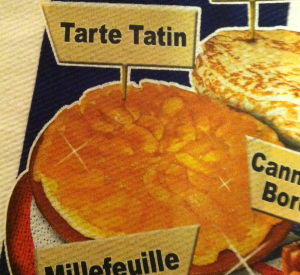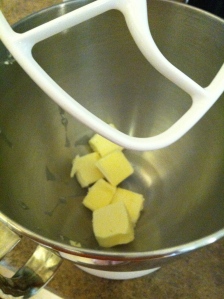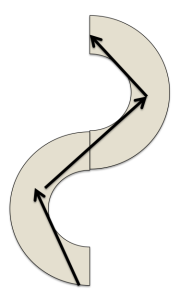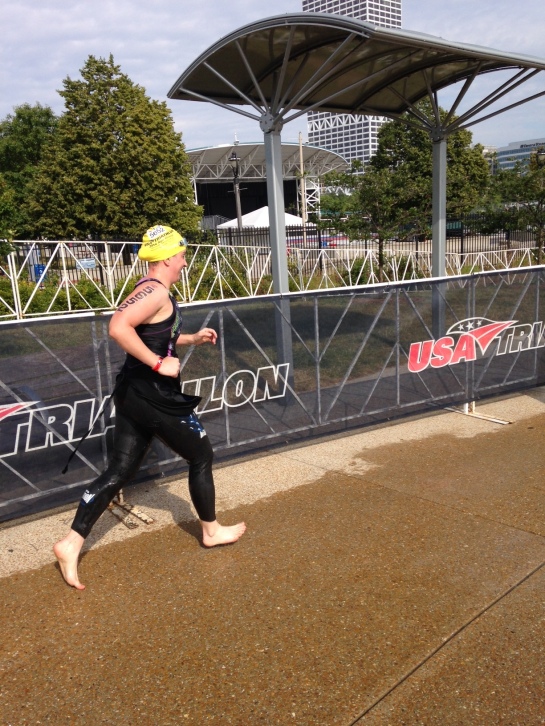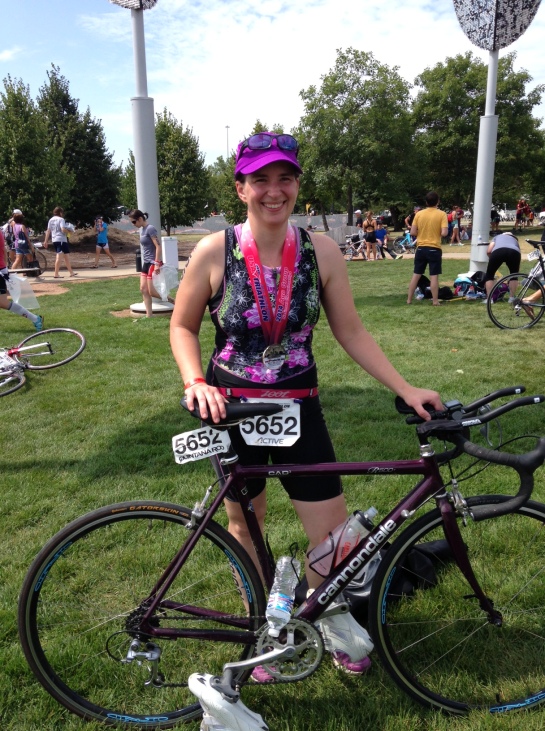I’ve been very lax in my blogging updates, and the further behind I get, the more insurmountable it feels to start again. So instead of doing full race reports for the summer’s races, I’m going to do top highlights and memories of the summer’s races in this monster combo blog. We’ll say monster in honor of the haunting month of October. Why not?
Verona Triterium Olympic Distance:
This was my first Olympic distance race and I have to admit I was quite nervous going into it. I didn’t really have a great idea of what goal times to shoot for, so I decided to just say under three hours was my main goal because it seemed like a round number and a reasonable timeframe.
The highlights:
Bathroom milestones:
About a year ago I was reading a 70.3 race report and mentioned to Josh that this woman had a great idea: if you sit down on the grass during transition to put your shoes on, you can go to the bathroom without having to waste time in the portapotty. He said, “I will never do a sport where I need to intentionally soil myself.” He is a wise man.
Me, on the other hand, not so much. I’ve never needed to use the bathroom during the race, and Verona was no different, but before the race was a different story. There were literally 7 portapotties at this venue (there were 433 participants total in the sprint and olympic races, plus relay teams). I had to go to the bathroom after I’d set up the transition area and the portapotty I went into was so disgusting by that point that I spend most of the time retching and trying to hurry up and finish.
Mine was the very last wave to leave, and it was an in-water start. When faced with the decision of whether to try to use the portapotty again or wait to relieve myself in the water before the start, I chose the latter and I don’t regret that decision.
Timing malfunction:
Unfortunately, I was so focused on doing what I needed to do that I forgot to start my watch before the race. Verona’s Olympic-distance swim is three loops of the quarry. In between each loop you have to get out of the water and run around a tree on the beach. I started my watch the first time I ran around the tree, but forgot about this fact later in the race so I thought I was doing about 9 minutes better than I actually was.
Looped swim:
As I said, my wave was the very last to leave, and the swim was three loops. This meant I had a lot of people to swim through and around as I passed the slower folks in the waves before me. There were three women who took off way in the front of my wave and I was a part of the chase pack of about 6-8 women. On the plus side, it kept things interesting, as there was plenty of maneuvering to be done.
I loved the swim. I felt calm and smooth the whole time and I feel like I made up a lot of ground on the earlier waves.
Holy hills:
I knew the bike course was hilly. I rode it a week or two before the race and was suitably impressed. This race has one of those “king of the mountain” hills (Observatory Hill, in this case), where there’s a timing mat at the bottom and at the top and the fastest bike splits get prizes. I knew I had no chance of being in the running for that. Originally, the course had you doing two loops, so you’d go up the hill twice. Due to road construction, they had to change the course at the last minute to be sort of a pronged out and back. This meant you still had to go up Observatory twice, but now those two rides were immediately one after the other. So you went up to the south, rode down, turned around, and went right back up again to the north. It was an exciting feeling in the legs, to try to put a positive spin on it.
Not unexpectedly, I was passed by lots of men on the bike and some women. I took solace in the fact that anyone passing me was someone I had to have beaten in the swim, given that my wave had left last. There were a lot of men passing me on the bike, so at least I out-swam them!
Run:
I love the 10k distance for straight up running races. I was nervous about doing it after the leg pounding of the bike, but it was actually fairly comfortable. I had a stomach cramp most of the way but nothing too bad. I think I took things a bit too easy on myself, though. For the first time at this distance, it’s understandable, but I think I could have gone faster. I was running about 8:45 pace, but I was straight up strolling through the aid stations. In the future, I’ll walk if I need to so I can make sure I get in the hydration, but a power walk with some purpose would be more appropriate. I really wanted to finish the 10k in under an hour (my PR for a 10k when I’m only running, not triathloning, is 53:30). I came in at about 58:xx, so I was happy with that.
Overall:
Swim (1500 meters): 28:20
T1: 2:18 (the run from the swim out mat to transition is pretty long, to be fair)
Bike (22.1 miles): 1:26:35.
T2: 1:31
Run (10k): 58:44
Total: 2:57:26
6th in my age group and 38th female overall.
USAT Age Group Nationals Sprint:
My next race was a return to USAT Age Group Nationals in Milwaukee for another crack at the sprint race. I was definitely excited about this because I felt like I’d been working a lot on my running (specifically doing quite a bit of speed work with the Fleet Feet SpeedPlay group) and had improved my bike since last year.
Pre-race:
Again, my wave was towards the back of the race. I got my stuff set up in transition early and then waited three hours until my wave took off. My friend Leslie is one year older than me so was in the 35-39 age group, which was the second wave to take off. So I got to see her swim, her T1 and T2, and then got myself suited up and ready to go. She ran up behind me right before the swim start, having just finished her race, so it was awesome to see my partner in crime before heading out.
Swim:
The swim was in Lake Michigan, and it was COLD. Like, take your breath away cold. I was nervous about it, and although I had enough time to get my breathing under control and loosen up that clenching in your chest that you get when you jump into cold water, the wait for the horn to go off was long enough for my feet to really start to feel it. This year, we all had to have a hand on the dock before starting the swim which was different than last year when we were treading water. I get why they did it (people were creeping up like crazy), but it did make for some close quarters with everyone crammed in together. It was nice to chat a bit with the women in my wave before we took off, though.
Once the horn went off, adrenaline kicked in and I was plenty warm within about 45 seconds. I felt like I was pushing the pace a bit. I knew I wasn’t in the front of the group, but I felt like we were all pretty much one big pack and I was in line about where I’d expect.
The best part about the nationals course in Milwaukee is swimming underneath the little footbridge. You can hear the crowd cheering, which you normally don’t get to experience during a swim, and it’s just cool and echo-y under there. I was happy that I was noticing these things and enjoying the experience. The second best part is that when you get out of the water, you go up a steep and slippery ramp, and there’s a line of volunteers who grab onto your hands and pull you up.
T1:
The transition area at Nationals is huge, but all the rows are marked by letters, so you can keep track of which row you need to run down. Last year I was between I and J, so I remembered that by saying “I Jive” when running around. This year, I was between H and I, so I went with the perhaps less fun but more straightforward “Hi!”
When running out of transition, I was booking it. There was a little plywood ramp set up leading out of transition and onto the sidewalk, and I was running a little too fast and trying to pass a woman at the same time, so my bike wheel bounced sideways off the ramp and my bike almost fell over (would probably have taken me along with it). I caught it mid-air in a semi-ninja fashion and kept running. I heard a guy in the crowd yell “Nice recovery!” and took off with a smile.
Bike:
Not shockingly, I was passed by a lot of women on the bike. However, my speed looked good on my bike computer (in the low 20s) and I felt really good. I was able to stay in aero for most of the time. At nationals there are always a lot of bike marshals on the course so I was careful when passing and being passed to fall back quickly and pass quickly.
The third coolest thing about nationals is that you get to ride your bike on the interstate. They shut down part of I-794 and you ride up the entrance ramp and across a bridge over the water. It’s actually a pretty painful ride, as it’s really bumpy and there are a lot of cracks that shake you around, but it’s so cool to be in forbidden territory that it’s totally worth it.
As I was climbing up the surprisingly steep entrance to the interstate, a huge pack of the 24 and under men passed me. They were the last wave of the day and the only one behind my wave. There were probably 30 of them in this pack and they were all riding so close together, drafting like crazy. There was absolutely nothing I could do to ride legally in this situation, and right as this was happening, a motorcycle drove up and stayed with the group as the official on the back furiously wrote down race numbers. I was really frustrated and just hoping I wasn’t going to get penalized, but there was nothing I could do about it other than come to a dead halt, so I just kept riding and they moved on soon enough.
Run:
I knew I wasn’t in contention at this race and had no illusions that I would be, but I was excited to have a good run. My legs felt as good as you could expect and the weather was perfect. I don’t remember much all that significant on the run, but I felt like I was keeping a good pace and was enjoying soaking up the race atmosphere. It’s hard to compete with the excitement and atmosphere of nationals.
Overall:
Swim (750 m): 14:31
T1: 1:46
Bike (12.4 miles): 39:54. I was happy to see that I didn’t get a penalty on the bike. Out of curiosity, I looked at the 24 and under men’s group, and there were a huge number of penalties given out to them, which felt fair.
T2: 1:24
Run (5k): 26:30
Total: 1:25:02
45th in my age group, 190th female
I was pretty disappointed with my performance in this race. My swim was slower than last year (which is weird), my bike was only very slightly faster, and my run was not as good as I had expected given all the work I’d put into it. Plus, my rank dropped within my age group, although that always depends on who shows up.
So, to make myself feel better, I found a small community triathlon being held just two weeks alter, and signed up. Coming up in part two of the monster recap I’ll let you know how that turned out, so stay tuned!
